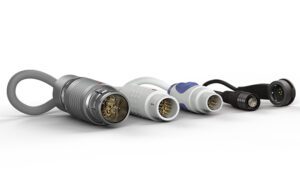
Fischer Connectors’ solutions suited for medical devices include several types of connectors and associated cables (from left): Fischer Core Series Brass, Plastic, Disposable, Fischer MiniMax Series, and the Fischer Freedom Series. [Photo courtesy of Fischer Connectors]
Connectivity for safety and performance is a complex consideration when designing modern medical equipment.
David Ptacek, Fischer Connectors
In patient care settings from surgical to imaging and diagnostics, therapeutics and patient self-care, the use of medical electronic equipment is ubiquitous and continues to grow. Advanced technology featured in new equipment and devices is bringing about ever more innovation to benefit patient experience and outcomes.
Such new designs typically need to integrate connectivity solutions: cables, connectors and electronics. Even though it may seem straightforward, connectivity today is a complex endeavor.
Connectors, cables and electronics are becoming more advanced in enabling electronic equipment to operate safely and reliably. If one connector fails, it could render the whole device inoperable, including the entire electronic ecosystem that was integrated with the device. This is one reason it is so important for connectivity solutions to be dependable in data transmission, robust in functionality and meet critical regulatory requirements.
Performance requirements vary and must also be considered when evaluating connectivity solutions.
Operational factors
Connectivity solutions must first ensure safety for medical personnel and patients, while offering a comfortable user experience and appropriate characteristics for the setting where they are used.
In an operating theater, numerous actors engage in a myriad of patient interventions. Surgeon operated headsets can be used to deliver optimal lighting during a procedure. To stop a cable from slipping into the surgeon’s field of vision, a special 360-degree pluggable connector solution can ensure the cable remains in position while connected to the device, regardless of the surgeon’s movements.
In-home patient wearable applications provide additional examples that involve finding the right connectivity solution that is lightweight, durable, dependable, comfortable and easy to use.

Connectivity solutions used in medical exoskeletons such as TWIICE must be robust, compact, lightweight and easy to use. [Photo by Alain Herzog for TWIICE]
Connectivity solutions have helped revolutionize modular and lightweight exoskeletons, where the motors at the joints require transmission between the joint and the controller. These connectors must be rugged for various environments and easy to clean. Weight can also play a role, one reason connectors are often manufactured from chrome-plated aluminum versus traditional heavier brass.
These examples demonstrate the versatility of connectivity solutions, especially where operational excellence is a key consideration.
Specification assessment
As you know, medical devices are highly regulated and must meet rigid certification requirements. For example, ISO 13485:2016, the internationally recognized quality systems standard for medical device manufacturers, also extends to their suppliers. This ensures that components are compliant, safe and reliable for integration into medical devices.
Environmental considerations can also impact connectivity design specifications. For instance, medical equipment connectors must be resistant to dust, dirt, debris and moisture incursion. In the case of liquid contact, connectors with IP68 sealing rates are protected from water ingress in both mated and unmated states. When sterilization needs arise, connectors and cables should be able to withstand high temperatures associated with autoclaving.
Durability and ease of use with connectivity solutions come into play when there are high numbers of mating cycles and frequent plug/unplug situations. A good measure is 10,000 mating cycles in cases such as diagnostic and imaging solutions. Connectivity action should be intuitive for all users — from trained to untrained — to alleviate issues with mating or damage to equipment.
When assessing weight and size considerations with wearables and in-home patient devices, connectivity solutions can be customized. With device miniaturization on a fast track, customized solutions that are compact, lightweight and deliver the needed power and fast data transmission can support a successful and efficient deployment.
Selecting the right locking mechanisms
When mating connectors, several locking mechanism choices are available to meet requirements that aid the coupling and uncoupling of the mating parts. These mechanisms secure the connectors in an optimal operating position and assure the accurate electrical continuity and speed that is needed between the cable and the device.
Robust options entail push-pull, breakaway and screw. Blind mating brings benefits when connectivity lacks a clear line of sight. Color-coding identification is also popular.
Looking to the future
The future will bring new ways of treating disease and managing healthcare delivery. Medical devices will continue to evolve and dramatically enhance the practice of medicine. Many of these devices will require a vast range of connectivity solutions. The opportunities are endless with versatile and customizable connectors, cable assemblies and electronic solutions.
With IT-enabled and interoperable medical devices, electrical and optical connectivity solutions are playing a vital role in advancing product capabilities and will continue to be a contributor to innovative advancements in healthcare.

David Ptacek [Photo courtesy of Fischer Connectors]
David Ptacek is national sales director of Fischer Connectors, responsible for sales and product development in North America and Latin America. With more than 20 years of experience in the B2B interconnect industry, Ptacek works closely with top medical device manufacturers to co-create innovative products using the latest in connectivity technology.
The opinions expressed in this post are the author’s only and do not necessarily reflect those of MedicalDesignandOutsourcing.com or its employees.